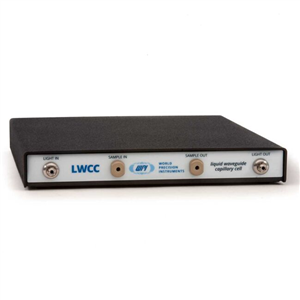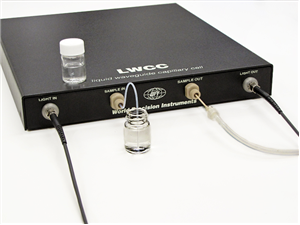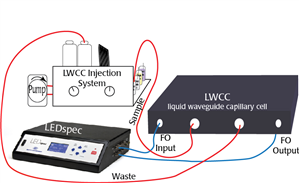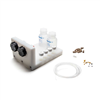

LWCC-3100
100cm Liquid Waveguide Capillary Flow Cell
- Overview
- Specifications
- Accessories
- Citations
- Related Products
Overview



There are 3 images available to view - click to enlarge and scroll through the product gallery.
Data Sheet
/ Download as PDF
Manual
/ Download as PDF
- 250-uL Internal Sample Volume
- Improve sensitivity 100 times vs standard quartz type 10-mm cuvettes.
- Wavelength Range: 230-730nm
Microliter sample volumes — exceptional sensitivity
WPI’s Liquid Waveguide Capillary Cell (LWCC) is a flow cell for absorbance measurements in the ultraviolet, visible and near infra-red ranges. Pathlengths range from 50–500cm, with increasing measuement sensitivity from 50 to 500-fold. The flow cells are fiber coupled and have a very small sample volume ranging from 125mL (50cm pathlength) to 1,250mL (500cm pathlength).
How does it work?
The sample solution is introduced into the LWCC at the liquid input. Light is coupled into the LWCC from a light source via a fiber optic cable. After passing through the LWCC, light is collected with an optical fiber and guided to a detector. The concentration of the sample is determined by measuring its absorbance in the LWCC, similar to a standard UV/VIS spectrometer.

These spectra show the optimal detection limits for LWCCs of varying pathlength.
Advantages of LWCC over standard cuvettes
Ultra-sensitive absorbance measurements can be performed in the UV, VIS, and NIR portion of the light spectrum. Compared with a standard 1cm cuvette, a 1mAU signal is enhanced 100-fold to 100mAU when using an LWCC-3100. LWCC units can be directly connected to a pump, a fluid injection analysis system, or even filled with a syringe.
Detector requirements
Based on fiber optics, the LWCC is designed for use with WPI’s LEDspec (biophotometric detection system), Tidas I, Tidas 100 and Tidas E spectrometer systems. The LWCC can also be interfaced to any CCD, PDA or scanning type optical spectrometer or photodiode detector with fiber optic input capabilities. WPI also offers a range of light sources, such as FO-6000 (VIS/NIR studies) and D4H (UV/VIS) which can be used in conjunction with the LWCC.
Wavelength range
Designed to work in the UV, VIS and NIR, the LWCC's optical performance is strongly dependent on the solvent used in the wavelength of interest. Please note that in aqueous solutions the wavelength performance is limited (see Efficiency Curves).
| Pathlength [cm] |
Internal Volume [µL]
|
Wavelength Range [nm] measured with Tidas II |
|
| LWCC-3050 | 50 | 125 | 230-800 |
| LWCC-3100 | 100 | 250 | 230-730 |
| LWCC-3250 | 250 | 625 | 250-730 |
| LWCC-3500 | 500 | 1250 | 280-730 |
Linearity
By Beer’s Law, the absorption of a liquid sample in LWCC bears a linear relationship to the concentration of an analyte. A linear relationship is observed between 0.01–2AU and is limited only by stray light and noise from the spectrometer.
Chemical resistance
Any chemicals that could react with PEEK, Polyimide and fused silica should not be used in LWCC. (If in doubt, please contact WPI for details.)
Applications
Applications include liquid chromatography detection, stopped-flow injection, flow-injection analysis, gas-segmented continuous flow analysis and water monitoring (environmental, oceanic, and drinking water). Please contact WPI to discuss your needs.
Specifications
| LWCC-3050 | LWCC-3100 | LWCC-3250 | LWCC-3500 | |
| Optical Pathlength | 50cm | 100cm | 250cm | 500cm |
| Internal Volume | 125µL | 250µL | 625µL | 1250µL |
| Fiber Connection | 500µm SMA | 500µm SMA | 500µm SMA | 500µm SMA |
| Transmission @254nm* | >20 | >10 | >1 | - |
| Transmission @540nm* | >35 | >30 | >30 | 20 |
| Noise [mAU]** | < 0.1 | < 0.2 | < 1.0 | |
| Maximum Pressure | 100 PSI | 100 PSI | 100 PSI | 100 PSI |
| Wetted Material | PEEK, Fused Silica, PTFE | PEEK, Fused Silica, PTFE | PEEK, Fused Silica, PTFE | PEEK, Fused Silica, PTFE |
| Liquid Input | Standard 10-32 Coned Port Fitting | Standard 10-32 Coned Port Fitting | Standard 10-32 Coned Port Fitting | Standard 10-32 Coned Port Fitting |
* Referenced using coupled 500µm fibers
** Measured using ASTM E685-93
*** A one-meter waveguide of 550µm internal diameter requires approximately 1.5PSI for water flow of 1.0mL/min.

When comparing light throughput versus wavelength of three fiber optic cables, the greater the diameter of the cable, the better the LWCC performance up to 500µm which is the input diameter of the SMA connector.
Accessories
Citations
Bonifay, V., Barrett, T., & Pattison, D. (2014). Tryptophan oxidation in proteins exposed to thiocyanate-derived oxidants. Archives of biochemistry …. Retrieved from https://www.sciencedirect.com/science/article/pii/S0003986114003142
Catelani, T., Tóth, I., Lima, J., Pezza, L., & Pezza, H. (2014). A simple and rapid screening method for sulfonamides in honey using a flow injection system coupled to a liquid waveguide capillary cell. Talanta. Retrieved from https://www.sciencedirect.com/science/article/pii/S0039914013010163
Chaparro, L., Ferrer, L., Leal, L., & Cerdà, V. (2014). A multisyringe flow-based system for kinetic–catalytic determination of cobalt (II). Talanta. Retrieved from https://www.sciencedirect.com/science/article/pii/S0039914014005360
Du, Z., He, K., Cheng, Y., Duan, F., & Ma, Y. (2014). A yearlong study of water-soluble organic carbon in Beijing II: Light absorption properties. Atmospheric …. Retrieved from https://www.sciencedirect.com/science/article/pii/S1352231014001186
Fang, T., Verma, V., & Guo, H. (2014). A semi-automated system for quantifying the oxidative potential of ambient particles in aqueous extracts using the dithiothreitol (DTT) assay: results from the. Atmospheric …. Retrieved from https://www.atmos-meas-tech-discuss.net/7/7245/2014/
Gil-Lozano, C., & Losa-Adams, E. (2014). Pyrite nanoparticles as a Fenton-like reagent for in situ remediation of organic pollutants. Beilstein journal of …. Retrieved from https://www.beilstein-journals.org/bjnano/content/5/1/97
Hopwood, M., Statham, P., & Milani, A. (2014). Dissolved Fe (II) in a river-estuary system rich in dissolved organic matter. Estuarine, Coastal and Shelf Science. Retrieved from https://www.sciencedirect.com/science/article/pii/S0272771414002674
Kolacinska, K., & Trojanowicz, M. (2014). Application of flow analysis in determination of selected radionuclides. Talanta. Retrieved from https://www.sciencedirect.com/science/article/pii/S0039914014001556
Kröckel, L., Lehmann, H., Wieduwilt, T., & Schmidt, M. (2014). Fluorescence detection for phosphate monitoring using reverse injection analysis. Talanta. Retrieved from https://www.sciencedirect.com/science/article/pii/S0039914014001702
Lee, S., Cha, W., Kim, J., Baik, M., & Jung, E. (2014). Uranium (IV) remobilization under sulfate reducing conditions. Chemical …. Retrieved from https://www.sciencedirect.com/science/article/pii/S0009254114000618
Ma, J., Adornato, L., Byrne, R., & Yuan, D. (2014). Determination of nanomolar levels of nutrients in seawater. TrAC Trends in Analytical Chemistry. Retrieved from https://www.sciencedirect.com/science/article/pii/S0165993614001095
Maugendre, L., & Gattuso, J. (2014). Effect of ocean warming and acidification on a plankton community in the NW Mediterranean Sea. ICES Journal of …. Retrieved from https://icesjms.oxfordjournals.org/content/early/2014/09/24/icesjms.fsu161.short
Milani, A. (2014). Development of microfluidic technology for in-situ determination of iron and manganese in natural aquatic systems. Retrieved from https://eprints.soton.ac.uk/365471/
Moreno, D. V., & Manchado, P. (n.d.). Optical phytoplankton discriminator (OPD) developed for a gliper. upcommons.upc.edu. Retrieved from https://upcommons.upc.edu/revistes/handle/2099/14693
Ogawa, H., Kogure, K., & Kanda, J. (2014). Detailed Variations in Bioactive Elements in the Surface Ocean and Their Interaction with Microbiological Processes. Retrieved from https://www.terrapub.co.jp/e-library/w-pass/pdf/w-pass_177.pdf
Powers, L., & Miller, W. (2014). Blending remote sensing data products to estimate photochemical production of hydrogen peroxide and superoxide in the surface ocean. Environmental Science: Processes & Impacts. Retrieved from https://pubs.rsc.org/EN/content/articlehtml/2014/em/c3em00617d
Pulido-Villena, E. (2014). Microbial food web dynamics in response to a Saharan dust event: results from a mesocosm study in the oligotrophic Mediterranean Sea. Biogeosciences …. Retrieved from https://www.biogeosciences-discuss.net/11/337/2014/bgd-11-337-2014.html
Ridame, C., & Dekaezemacker, J. (2014). Contrasted Saharan dust events in LNLC environments: impact on nutrient dynamics and primary production. …. Retrieved from https://www.biogeosciences.net/11/4783/2014/bg-11-4783-2014.html
Srinivas, B., & Sarin, M. (2014). Brown carbon in atmospheric outflow from the Indo-Gangetic Plain: Mass absorption efficiency and temporal variability. Atmospheric Environment. Retrieved from https://www.sciencedirect.com/science/article/pii/S1352231014002015
Srinivas, B., Sarin, M., & Sarma, V. (2014). Atmospheric outflow of nutrients to the Bay of Bengal: Impact of anthropogenic sources. Journal of Marine Systems. Retrieved from https://www.sciencedirect.com/science/article/pii/S0924796314001742
Sunscreens as a Source of Hydrogen Peroxide Production in Coastal Waters. (2014).Environmental science & …. Retrieved from https://pubs.acs.org/doi/abs/10.1021/es5020696
Uthuppu, B. (2014). Polymer coated gold nanoparticles for tracing the mobility of engineered nanoparticles in the subsurface. European …. Retrieved from https://meetingorganizer.copernicus.org/EGU2014/EGU2014-5719.pdf
Yuan, X., Miller, C., Pham, A., & Waite, T. (2014). Kinetics and mechanism of auto-and copper-catalyzed oxidation of 1, 4-naphthohydroquinone. Free Radical Biology and …. Retrieved from https://www.sciencedirect.com/science/article/pii/S0891584914001385
Zhu, Y., Yuan, D., Huang, Y., Ma, J., Feng, S., & Lin, K. (2014). A modified method for on-line determination of trace ammonium in seawater with a long-path liquid waveguide capillary cell and spectrophotometric detection. Marine Chemistry. Retrieved from https://www.sciencedirect.com/science/article/pii/S0304420314000620





Request
Catalogue
Chat
Print